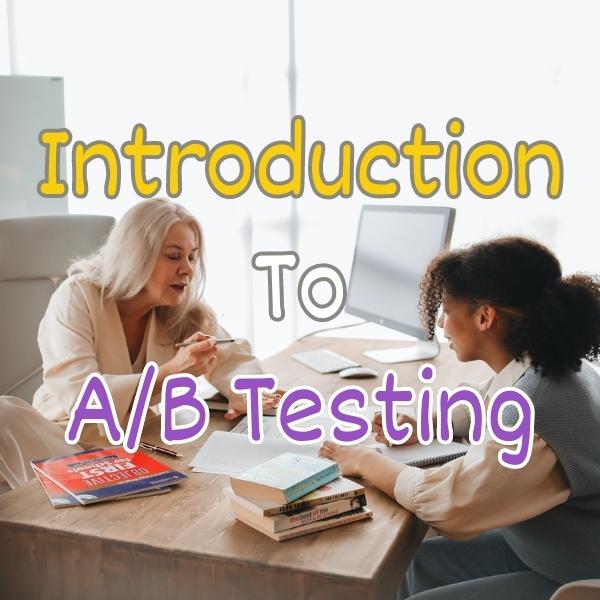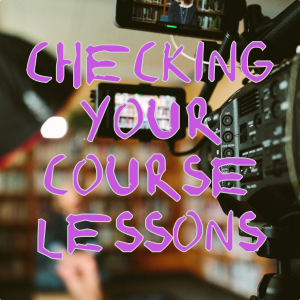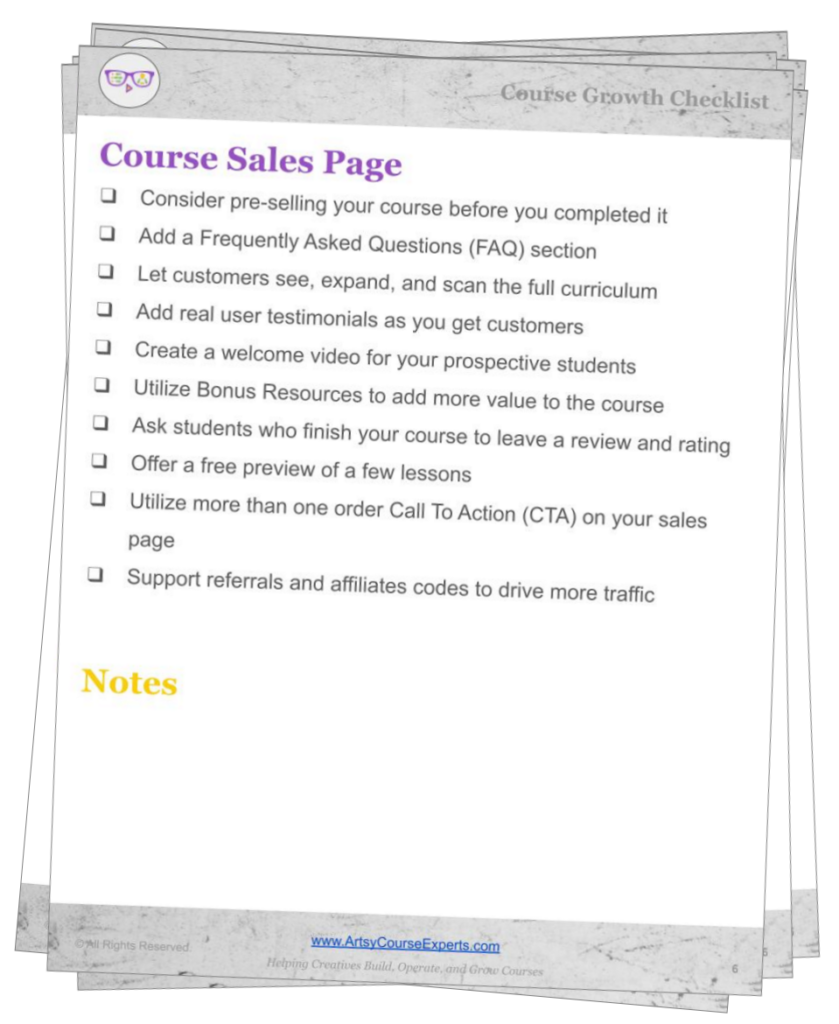Introduction
Having a great online course is every online teacher’s dream. The objective is to share valuable skills and information with your community, aiding them in solving their problems and finding answers to their questions. With your online course in place, here’s a lesson on how to connect with potential students and boost your sales.
IIn this lesson, we will delve into A/B testing, a technique that can enhance your sales and the effectiveness of your course community and teacher websites. We’ll cover what A/B testing entails and the reasons for its usage. Additionally, we’ll explore how to conduct A/B testing with the help of an example..
Challenges course creators can face if they don’t use A/B Testing:
- You may see minimal or no business growth.
- Attracting more sales to your online course business could be a struggle.
- You’ll never know if your webpage would perform better with a new process
- By not trying something new, you risk getting the same results in your sales.
- There won’t be opportunities to enhance your sales, content, and experiments across all your businesses.
Video Lesson – How To Increase Your Customers and Sales with A/B Testing
What is A/B Testing?
A/B testing is a process where you try multiple experiments to increase sales for your online course and see which performs better. Then you choose the winner and implement it. It’s called A/B testing because often you’re just doing two experiments at a time. Although, it’s possible that you could do multiple experiments at the same time.
Why Use A/B Testing?
Utilizing A/B testing allows you to rapidly enhance your conversion rates. You might find yourself in a situation where you decide to try a slightly different test from what you currently have, just to see how it performs.
It’s possible that this new variation boosts the effectiveness of your sales page, leading to increased sales. In such cases, you can proceed to implement the successful change. However, if the new alteration doesn’t yield the desired results, you can stick with the existing solution and plan a new A/B test for the following month.
Overtime, these tests will help you improve your sales, your content and your experience across all your businesses.
Without A/B testing, you risk becoming stagnant. Your business might seem stuck, and you’ll be left wondering what’s happening. By not exploring new ideas, you’re likely to achieve the same outcomes.
You may be putting in more effort, but without conducting experiments on various aspects of your business, including the sales page, content, onboarding, emails, messaging, course layout, community engagement, video content, resources, headers, footers, and more, your business will remain static, hindering your potential for growth.
Who Can Use A/B Testing?
- Hair Stylist can use A/B testing to attract more customers and improve their number of visitors and people they render services to
- Graphic Designers can use A/B testing to know which process invites more students to read their free module on an online course
- Authors can use A/B testing to increase sales and induce more readers to buy their books
- Fashion Designers can use A/B testing to try out whether potential customers will buy their clothes, footwears and bags at the beginning of the webpage or at the end
- Bloggers can use A/B testing to increase traffic to their websites and get more readers to read their web content
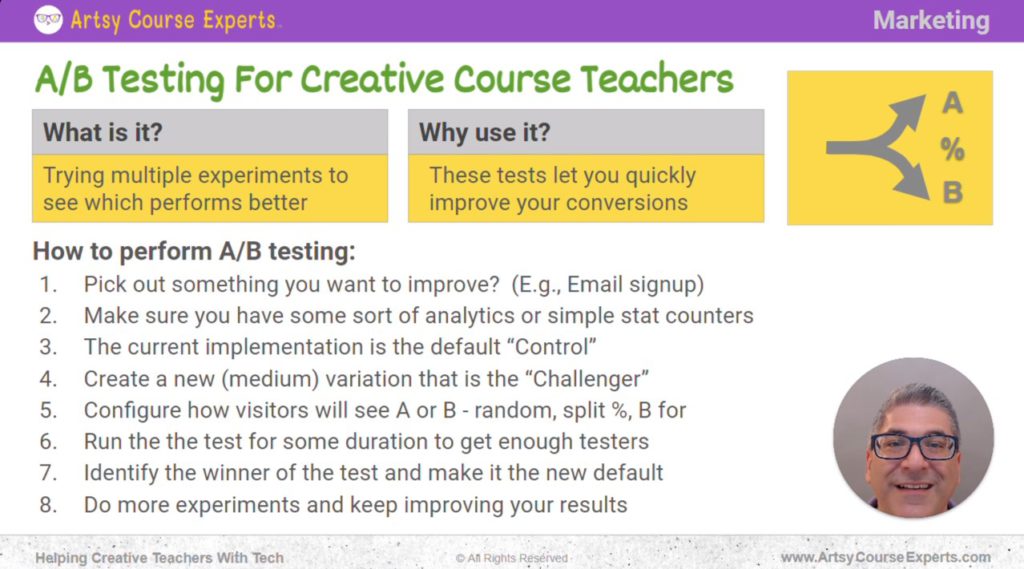
How to Perform A/B Testing
Let’s talk about how to perform A/B testing. This step by step guide will give you an insight on how you can do the test to improve your sales.
Pick Out Something You Want to Improve
First, you pick out something you want to improve. maybe you’re trying to improve the email signup on your webpage. This is where people type in their email and click on the subscribe icon. So we want to improve that and get more people to sign up. You’re getting visitors, but for some reason they’re not signing up.
Make Sure You Have Some Sort of Analytics or Stats or Counters or Metrics
The next step you’re going to do is to make sure you have some sort of analytics or stats or counters or metrics. You want to have some sort of tool, whether it’s Google Analytics or maybe you have something really simple like it’s built into WordPress or MailChimp, and it tells you how many visitors you have and how many people signed up. That way, you can know if your test actually worked.
The Current Implementation Is the “Default” Control
Next, you can have some a baseline. This is called your control and it’s your default implementation. You have something already working, let’s call it A and you want to compare it to something else you want to try, which would be B later.
Next, you establish a baseline, referred to as your control, which represents your default implementation. You’ve been working on this for weeks or months, and it serves as your foundation for comparison. Your current implementation, let’s call it A, is something that’s already operational. For instance, if you’re focusing on email sign-ups on a webpage, you know how many people typically sign up in a month. You’re familiar with the title, hook line, and lead magnet. You understand whether you’re collecting one or two pieces of information, such as first name, last name, or email. You’re aware of the button’s text and size. This detailed knowledge of your current setup serves as the control, a crucial part of your A/B testing.
Create a New (Medium) Variation Called the Challenger
Following the establishment of your control, you move on to what’s known as the challenger. You’ll introduce a significant variation, which doesn’t necessarily require an entirely new website, but it should be substantial.
You could be changing the color of your button or you’re changing the boldness and the hook of your message that says, “sign up to get tips about how to create a Graffiti”. This is your new variation, denoted as B, which you’re going to test. The objective is to compare the performance of this new variation against your established baseline, your control.
Configure How the New Visitors Will See A/B
Subsequently, you configure how the new visitors will interact with this B example. Some A/B testing systems are quite sophisticated and allow random selection for what users see. One user might see A, while another sees B. Alternatively, you could split the traffic, running your primary system alongside the new change for a specific percentage of visitors, such as 5%.
You could also just go all in. You’ve been doing this hook line for three months and now you’re about to change the title and the message. You’re just going to let it run a hundred percent for one month. You’re going to let everybody try out the new B test and see how it performs. So again, there are these technical systems that could distribute, and bring in all these other fancy things.
You can also go low tech and basically decide that since this other hook line performs at a 4% conversion, you can get to 5% or 6%. However, if it drops your conversion to 2%, you may revert to your control or devise a new experiment.
Run the Test for Some Duration to Get Enough
Next, you’re going to actually run the test for some duration. If it’s a small business, it’s recommended you run it for a month. That way you don’t deal with weekends or holidays or weather or any sort of variations that could potentially mislead your results.
You can let it run for a month. You know what the previous tests are, and you run a new one. In that month you know that you’re going to have a good statistical sample set with enough testers, and you’re going to get rid of the noise, like the weekends and holidays.
Identify the Winner of the Test and Make It the New Default
Whatever it is that you’re testing, you’re going to go get some math and see how this new element performed. If the new test performed better, then you should be getting ready to make that your default. If the new test perform better, students are happier, sales are higher. If it performed better, then that test should ultimately be promoted to all your users. and it’s the new baseline. Congrats! You’ve just leveled up.
Do More Improvements and Keep Improving Your Results
You’ll let that test run and you might actually go ahead and repeat this entire process and do another test. Maybe that got you from 4% to 6%. Luckily, this other change could get me from 6% to 8%.
By the way, when conducting these tests, you won’t be running numerous tests all at the same time. The goal is to isolate and determine whether a specific change is genuinely better.
However, in different segments of your system, you might be running multiple tests simultaneously. For instance, if you’re testing your webpage, you might run one or two tests to gauge their impact. But if you’re assessing your webpage, you may decide to implement one significant change at a time to observe whether it enhances or diminishes your results.
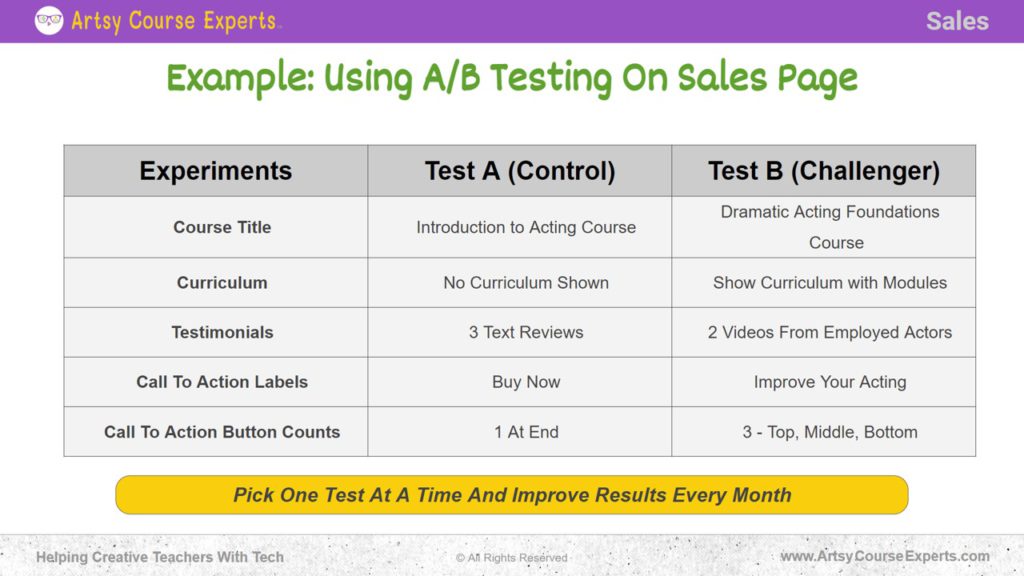
Examples of Using A/B Testing on a Sales Page
Let’s look at an example. In this example, we’re going to do A/B testing on a sales page. So let’s talk about a sales page for an online course on acting. We’ll use that as an example and list a couple of different things that we can do, but let’s try to not do all these experiments at the same time. But here are some different experiments that you can potentially do at different times.
Course Title
First of all, the course title. So you have a course that’s performing. it’s up and it’s live, you’ve got stats on it every month, you know how many leads are visiting your sales page, and you know how many people are actually buying your acting course. You might have a title that’s ‘Introduction to Acting.’
That’s the name of your course. You might decide to try something different. You can try “Dramatic Acting Foundations” course. So instead of an “Introduction to Acting” which is generic, you’re getting a little more specific with the dramatic, and you’re adding these foundations. It’ll be for beginners. You previously had ‘Introduction to Acting’ and now you will change the course title to ‘Dramatic’ and ‘Foundations’ That’s one test, and you’ll see how that performs.
Curriculum
Another test you could try is with your curriculum. It could be on your online course page for this acting course, you’re not even mentioning the curriculum.
It’s all about the pain, the goals, the dream and your experience. That’s great, but maybe you want to try to see if your course would sell better with a curriculum where you actually showed the high level modules. Mention the topics that will be covered and maybe even expose the lessons or even possibly let students try out a few free lessons.
A possible challenger test, a B test could be to actually show the curriculum. Try that out and see if your sales increase or decrease with that curriculum. By the way, another test could be moving the curriculum around. This could be the position of the curriculum. Whether it will be at the top, middle or near the end. Those are other tests that you can do in the future, but this first test is really about whether your course will sell better with or without the curriculum.
Testimonials
Next up is testimonials. On your online course page, you may have three columns. You’re listing some quotes about what other people said about your course, and these are testimonials from prior students. It says good things that will try to help you sell your course, but recently you’ve collected some videos from past students that are raving about your course.
Perhaps you may want to try replacing these text testimonials with video testimonials, so that could be an excellent test B, to see how text testimonials compares with video testimonials and if video helps you sell more. In the future you might want to do text and video as an alternative, just to see how that helps your sales page perform.
Call to Action Labels
Another A/B test you can do is call to action labels. These are the labels that are on the buttons that attract people and make them act on your course by buying or some other action. Traditionally, maybe as a default button on your online course, you might get a “buy now” or “enroll now”. That’s the default that came with the system and you never gave it much thought, but perhaps you may want to change that button to something else.
So that could be a great A/B test. Maybe your button is very specific to your students. Maybe it’s “improve your acting” or “learn to act now.”
Call to Action Button Counts
Another thing that you can do is to increase the number of ‘buy’ buttons on your sales page. These are the call to action buttons. By default your sales page may have one button by now, but you’ll go ahead and try three buttons.
One at the very top when they first land on your page. This is a way of prompting them to ‘buy now’ if they’re ready and it’s what they want. If not, they might scroll and look at your other pieces of content, that is, your features, benefits and curriculum. At that point, after seeing your curriculum, they’ll ready to buy. So you can have a second button there. You may have also decided to add a button at the bottom.
This is because some people scroll to the bottom and there’s no buy button. They could scroll up or just they hit the back button. So you decide with this experiment to add three buttons: at the top, the middle, and the bottom of your sales page.
Frequently Asked Questions on A/B Testing

Summary – A/B Testing
A/B testing is a really interesting experiment. This could potentially increase your sales from 2% conversion rate up to 10%. This is a very worthwhile and pretty easy experiment to do. If you want to level up, go ahead, pick one. Try out a simple test. Implement it for a month and see how much better or worse this new process is. If it worked out great, leave it. If it didn’t work, you can go back or try another experiment, and that’s it! That’s A/B testing.
Tips on A/B Testing:
- Pick out an area that’s a problem where you’ll test a new process.
- Make sure you have some basic stats before testing
- Do an experiment, let it run for a month and check the outcome
- You have to keep leveling up different parts of your online course business to get better sales
- Try out different processes for your online business to know the one that performs best
You should be a little smarter now. Thanks for hanging out!
Please subscribe to get more tips for creative online course teachers.
More Tips For Online Teachers
These lessons can also help you with Sales and Technology:
- How to Create a Product Ladder To Increase Sales
- Planning New Online Courses Using SWOT Analysis
- Understanding Your Ideal Target Audience For Online Course Teachers
- Handling Student Buyer’s Remorse For Online Courses
- VARK Learning Styles For Online Course Creators

